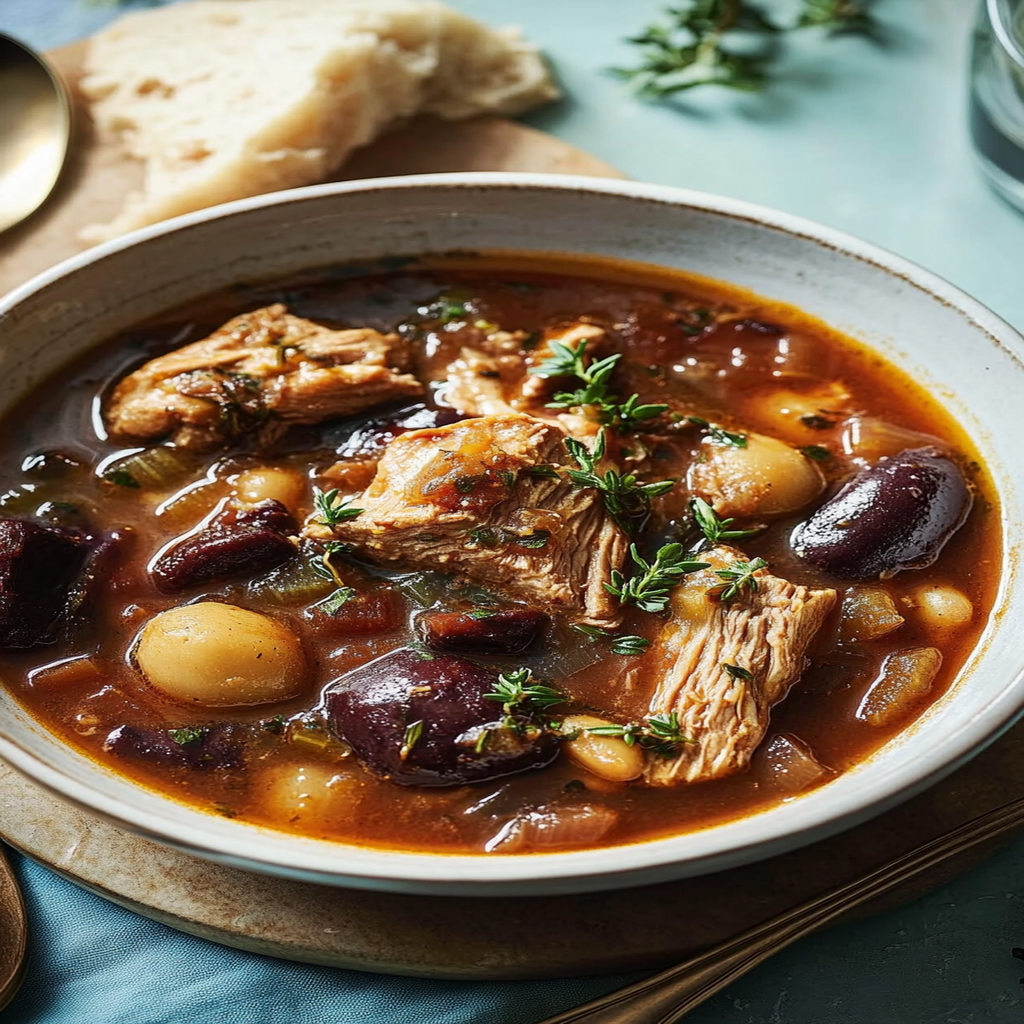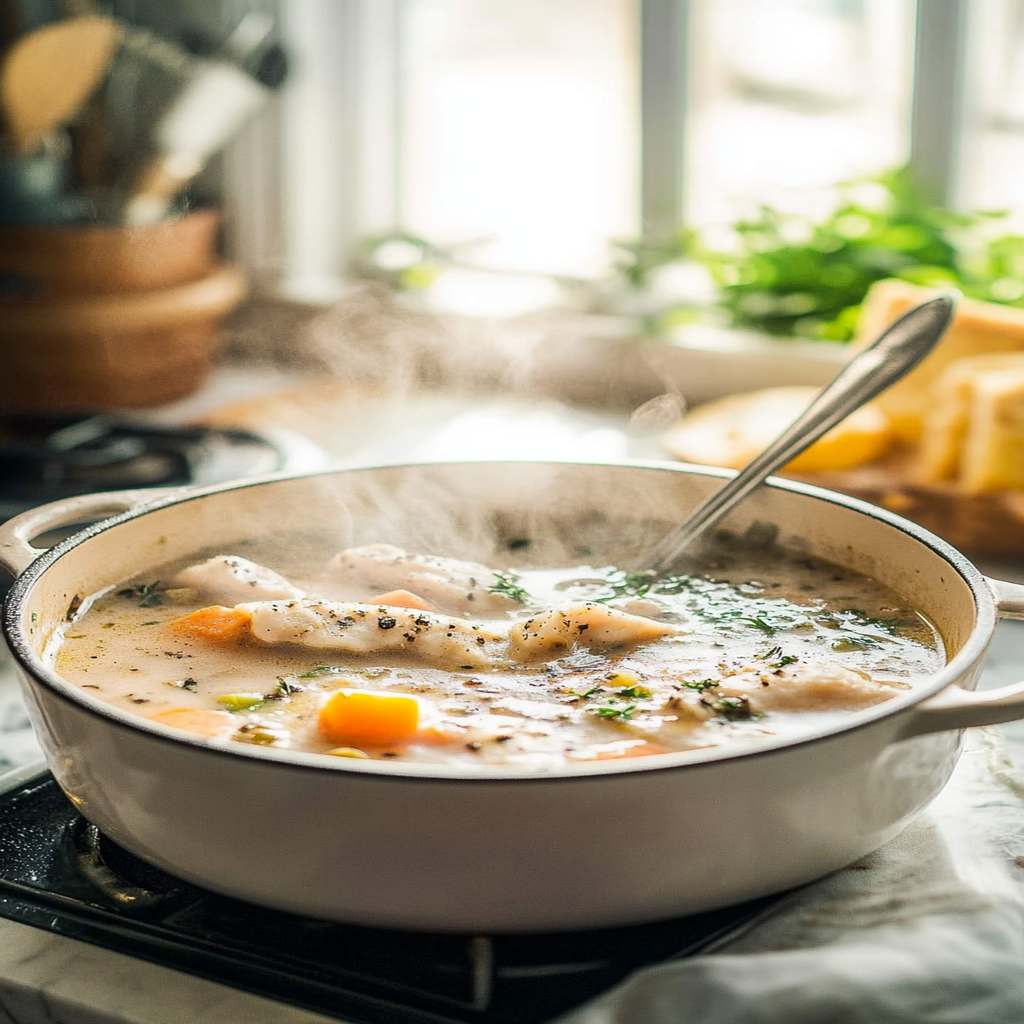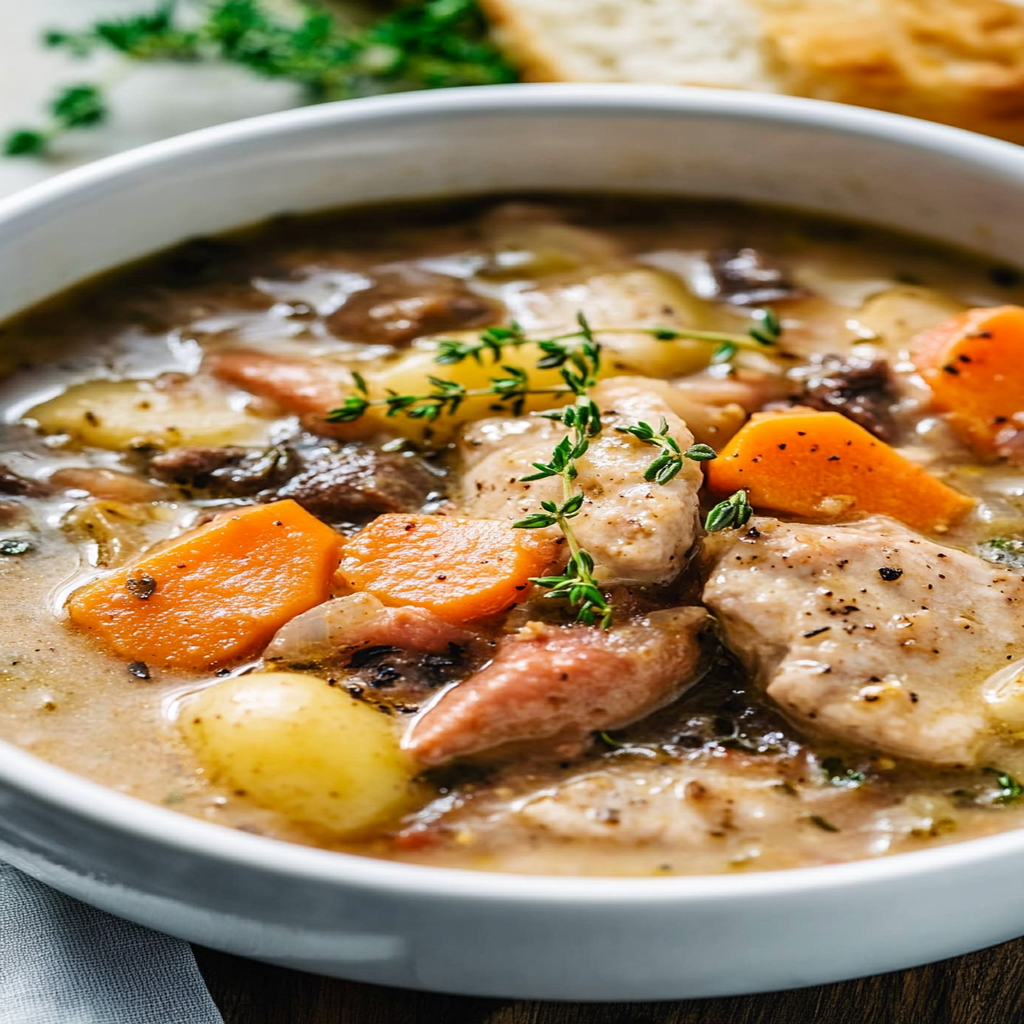Introduction and Quick Summary
One Pot Soups & Stews offer a convenient way to create hearty meals that warm both the body and soul. These dishes are not only comforting but also incredibly versatile. Whether you prefer a rich beef stew or a light vegetable soup, there’s something for everyone. The beauty of one pot cooking lies in its simplicity; you can toss all your ingredients into a single vessel and let them simmer together. This method not only saves time on cleanup but also allows flavors to meld beautifully.

In this article, we will explore various recipes that highlight the charm of one pot soups and stews. You will discover how easy it is to prepare these dishes with fresh ingredients and straightforward techniques. From classic chicken noodle soup to robust chili con carne, each recipe is designed to be straightforward yet satisfying. Perfect for busy weeknights or cozy weekends, these meals provide endless possibilities for customization based on what you have in your pantry.
Join us as we dive deeper into the world of one pot soups and stews. You’ll find detailed instructions on how to prepare each dish along with tips on serving and storing leftovers. By the end of this article, you will be equipped with the knowledge to create delicious one pot meals that your family will love.
Main Ingredients
Fresh Vegetables
Fresh vegetables are the foundation of any good one pot soup or stew. They add flavor, texture, and essential nutrients. Common choices include carrots, celery, onions, garlic, bell peppers, and tomatoes. Each vegetable brings its unique taste profile; for example, onions provide sweetness while garlic adds depth. Aim for about four cups of chopped vegetables in your recipe to create a balanced flavor base.
Proteins
Incorporating protein into your one pot soups & stews makes them more filling and nutritious. Options range from chicken breast or thighs to beans and lentils for vegetarian versions. For meat-based recipes, about 1 to 1.5 pounds is an ideal portion size depending on the number of servings needed. If using beans or lentils, roughly two cups will suffice.
Broth or Stock
Broth or stock serves as the liquid base for your dish, providing moisture and flavor throughout cooking. Chicken broth is popular but vegetable broth is an excellent option for vegetarian dishes. Using homemade stock enhances the taste significantly; however, store-bought varieties work just as well in a pinch. Aim for around six cups of broth to ensure your ingredients cook evenly without becoming too watery.
Herbs and Spices
Herbs and spices elevate your one pot soups & stews by adding aromatic elements that enhance overall flavor profiles. Popular choices include thyme, bay leaves, oregano, cumin, chili powder, black pepper, and salt. Fresh herbs should be added towards the end of cooking time while dried ones can be stirred in earlier on. Use about two tablespoons of fresh herbs or one tablespoon of dried herbs per recipe.
Grains or Pasta
Adding grains or pasta contributes heartiness to your dish while also absorbing flavors from other ingredients during cooking. Options include rice (white or brown), quinoa, barley, or pasta shapes like elbow macaroni or penne. Approximately one cup of dry grains or pasta works well when preparing a full batch of soup or stew.

How to Prepare One Pot Soups & Stews
Step 1: Sautéing Aromatics
Begin by heating oil in your large heavy-bottomed pot over medium heat until shimmering but not smoking—roughly 2 tablespoons should suffice depending on the amount being prepared! Add diced onions along with minced garlic; cook until fragrant (about 3 minutes). Next up are those colorful veggies! Stir them into the mix—carrots first followed by celery—to soften their edges before introducing additional seasonings such as salt and pepper.
Step 2: Browning Proteins
If using meat such as chicken or beef chunks in your recipe—now’s the time! Push aside sautéed vegetables slightly so they rest against cooler areas of pan enabling even browning on all sides without steaming them too much! This process takes around 6–8 minutes depending upon size/quality/quantity chosen (if opting completely vegetarian—skip this altogether!).
Step 3: Adding Broth
Once proteins have browned nicely (if applicable), pour in approximately six cups of broth/stock ensuring everything gets fully submerged! For extra depth add any canned tomatoes at this stage along with assorted spices/herbs mentioned previously—stir well before raising heat high enough bringing mixture up towards gentle boil!
Step 4: Incorporating Grains/Pasta
After reaching boiling point reduce temperature back down low allowing simmering action occur instead—this also allows flavors meld beautifully over time! Add desired grains/pasta now; ensuring they’re covered by liquid entirely! Cover lid tightly allowing steam build-up helps cook through evenly—check every ten minutes till grains/pasta achieve al dente texture (usually between twenty-thirty minutes).

Serving and Storing Tips
Serving Suggestions
Once cooked through thoroughly it’s time serve up those delicious bowls! Ladle generous portions into individual bowls garnished freshly chopped parsley/cilantro if desired! Pair alongside crusty bread rolls/cheesy toast making meal complete while enhancing overall satisfaction level amongst diners gathered around table together enjoying warm comfort food experience shared amongst loved ones!
Storing Leftovers
In case there are leftovers after serving—allow cooling first before transferring into airtight containers keeping fridge temperature below forty degrees Fahrenheit ensures freshness maintained longer periods! Typically stored properly lasts three-four days maximum retaining original taste textures intact when reheated slowly over stovetop/microwave before enjoying again later down line!
By following these guidelines on preparation methods alongside storage practices ensures successful outcomes every single time creating memorable moments enjoyed around dinner tables filled laughter joy family friends alike savoring delightful goodness held within bowls steaming hot ready devour!
Mistakes to avoid
One of the most common mistakes when making one pot soups and stews is not layering flavors properly. Many cooks tend to throw all ingredients into the pot at once, which can result in a flat and uninteresting taste. To maximize flavor, start by sautéing aromatic ingredients like onions, garlic, and spices in a bit of oil before adding other components. This step allows the flavors to bloom and creates a rich base for your soup or stew.
Another mistake is using low-quality or pre-packaged broth. Good broth can make or break your dish. It’s worth investing time in making homemade broth or choosing a high-quality store-bought option. When making one pot soups and stews, use fresh herbs, spices, and seasonings to elevate the taste. Dried herbs can work in a pinch but fresh options often provide brighter flavors that enhance the overall dish.
A frequent error is neglecting to adjust seasoning throughout the cooking process. Adding salt and pepper at the end can result in an under-seasoned dish. Instead, taste your soup or stew periodically while it cooks and adjust the seasoning accordingly. This practice helps ensure that every ingredient shines through without overwhelming the balance of flavors.
Lastly, overcooking vegetables can lead to mushy textures that detract from the dish’s appeal. Cook vegetables according to their required cooking times, adding sturdier ones like carrots or potatoes earlier than delicate greens that need only a brief cook time. This attention to detail will help maintain textures and create one pot soups and stews that are as pleasing to look at as they are to eat.

Tips and tricks
To create delicious one pot soups and stews, consider using a variety of textures in your ingredients. Combining different types of vegetables, grains, and proteins will not only enhance the visual appeal but also improve mouthfeel. For example, pairing tender beans with hearty root vegetables adds depth to your dish while keeping it interesting.
Choosing suitable cooking vessels is another essential tip for preparing one pot soups and stews effectively. Opt for heavy-bottomed pots that retain heat evenly; this will prevent hot spots that can burn your food. A Dutch oven or a large stockpot works well for this purpose. These types of cookware allow for even cooking and better flavor development.
Don’t forget about garnishes! Adding fresh herbs or toppings right before serving can elevate your dish significantly. A sprinkle of fresh parsley or cilantro adds brightness while also enhancing presentation. Consider also incorporating toppings like croutons or shredded cheese for added flavor and texture.
When planning meals ahead of time, consider batch cooking your one pot soups and stews. They make excellent leftovers, as many dishes taste even better the next day after flavors meld together in the fridge overnight. Store portions in airtight containers in either the refrigerator or freezer for quick meals on busy days.
Finally, keep an eye on cooking times for different ingredients within your recipe. Ingredients don’t always cook at the same rate; knowing when to add each component will ensure everything finishes perfectly tender without becoming mushy.
Suggestions for One Pot Soups & Stews
When preparing one pot soups and stews, try experimenting with various proteins such as chicken, beef, lentils, or chickpeas. Each option brings its unique flavor profile and texture that can transform your dish entirely. Choose proteins based on what you have available or what you crave; this flexibility allows you to create diverse meals without requiring extensive shopping trips.
Incorporate seasonal vegetables into your recipes whenever possible. Not only do these veggies pack fresh flavors but they also provide essential nutrients specific to their growing season. For instance, winter root vegetables like turnips or squash add heartiness during colder months while summer produce like zucchini or tomatoes brightens lighter fare in warmer seasons.
Consider incorporating different grains into your one pot soups and stews for added nutrition and heartiness as well as exciting textures! Options like quinoa, barley, rice, or farro complement various ingredients beautifully while providing wholesome benefits.
For those who love international cuisine, don’t hesitate to explore global flavors through spices! Adding spices such as cumin for warmth in Mexican dishes or ginger for zest in Asian-inspired recipes will take your meals on delightful culinary adventures while ensuring each bowl is bursting with flavor.
Finally, remember that presentation matters! Serve your finished dish with flair by utilizing colorful bowls garnished with fresh herbs or drizzles of extra virgin olive oil—this attention to aesthetics makes any meal feel special regardless of how simple it may be.

FAQs
What are some easy one pot soups & stews recipes?
Creating easy one pot soups & stews does not require advanced cooking skills! Start with simple combinations like vegetable soup using diced tomatoes alongside chopped carrots and celery simmered together with broth until tender—seasoning with salt and pepper enhances its flavor immensely! Additionally, try chicken noodle soup featuring cooked chicken breast mixed with egg noodles; just add broth along with seasonal veggies like peas before simmering until everything melds together nicely!
Can I prepare one pot soups & stews ahead of time?
Absolutely! In fact, many people find that preparing one pot soups & stews ahead boosts their flavors significantly since they have time to meld together overnight in the refrigerator! You can store leftovers easily by placing them into airtight containers—just reheat on stovetop when ready—saving both time during busy weeknights!
Are there vegetarian options available for one pot soups & stews?
Yes! One pot soups & stews are incredibly versatile dishes suitable for vegetarians too! Use vegetable broth instead of meat-based varieties; include legumes such as lentils or beans which add protein content while still offering satisfying textures alongside vibrant seasonal veggies!
How long does it take to cook one pot soups & stews?
The cooking time varies depending on recipe complexity but many traditional recipes fall between 30 minutes up-to 2 hours based upon ingredient choice(s). For instance lighter broths containing quicker-cooking vegetables might finish sooner than heartier ones needing longer simmering times due mainly due tougher cuts requiring tenderization over lengthy periods!
Can I freeze my leftovers from one pot soups & stews?
Yes! Most leftover portions from prepared dishes freeze beautifully allowing longer shelf life without sacrificing taste quality when reheated later down line—just ensure cooling completely before transferring into suitable freezer-safe containers then thawing overnight prior reheating!
Do I need special equipment for making one pot soups & stews?
No special equipment is required beyond basic kitchen tools such as pots/pans; however investing in items like Dutch ovens/pressure cookers can enhance overall experience providing versatility across various preparations along faster cooking methods ideal busy lifestyles!
Conclusion
In conclusion, mastering one pot soups & stews involves avoiding common mistakes such as failing to layer flavors properly or neglecting seasoning adjustments throughout cooking processes. By embracing essential tips—including experimenting with diverse ingredients while considering presentation—you’ll create satisfying dishes sure to impress family members during mealtime gatherings! Remember also that advance preparation boosts convenience; take advantage batch-cooking options freezing leftovers where appropriate ensures nourishments readily available during busier days ahead too!
By incorporating these guidelines into future culinary endeavors focusing specifically on creating delightful meals suited varying preferences alongside dietary restrictions leads towards ultimate satisfaction around dining tables everywhere—all through creativity born out simplicity found within comforting bowls filled nourishing goodness offered best through thoughtfully prepared homemade creations!



